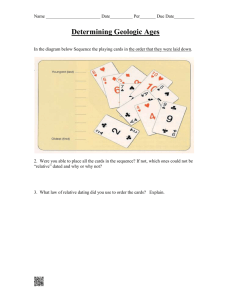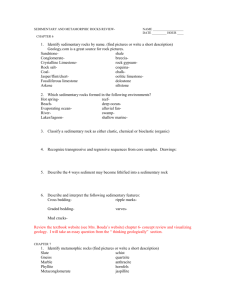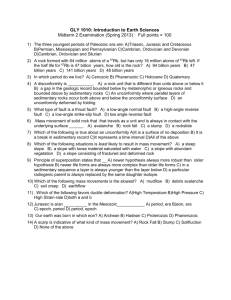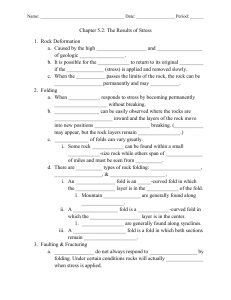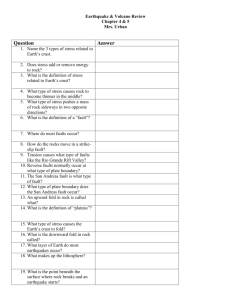Florida International University
advertisement
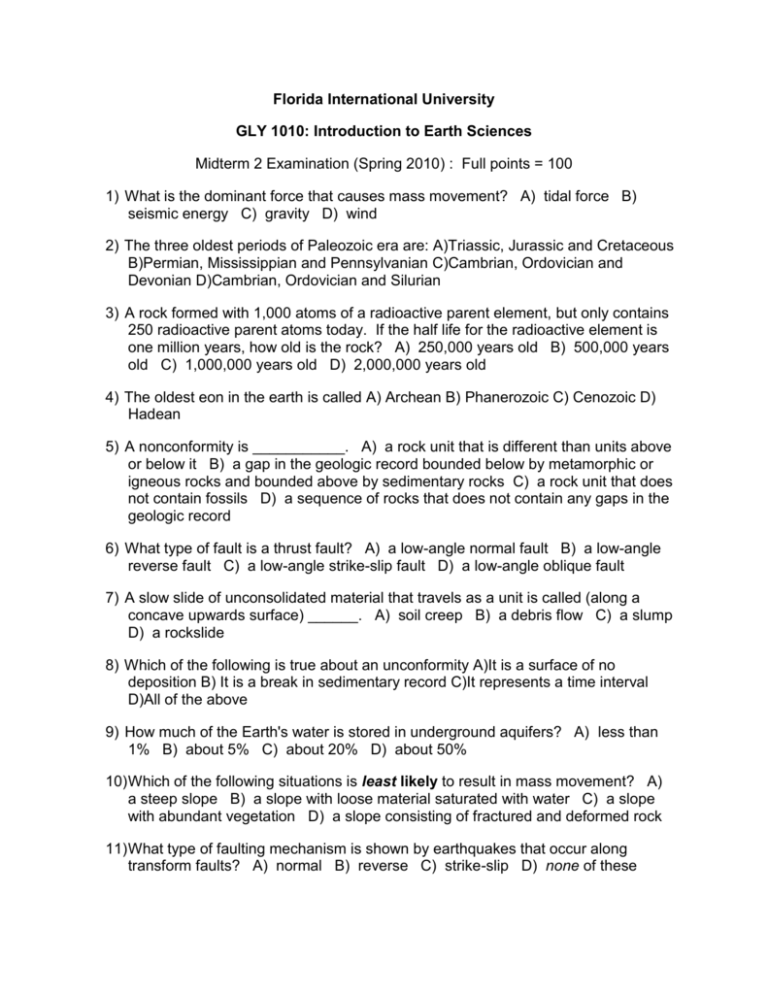
Florida International University GLY 1010: Introduction to Earth Sciences Midterm 2 Examination (Spring 2010) : Full points = 100 1) What is the dominant force that causes mass movement? A) tidal force B) seismic energy C) gravity D) wind 2) The three oldest periods of Paleozoic era are: A)Triassic, Jurassic and Cretaceous B)Permian, Mississippian and Pennsylvanian C)Cambrian, Ordovician and Devonian D)Cambrian, Ordovician and Silurian 3) A rock formed with 1,000 atoms of a radioactive parent element, but only contains 250 radioactive parent atoms today. If the half life for the radioactive element is one million years, how old is the rock? A) 250,000 years old B) 500,000 years old C) 1,000,000 years old D) 2,000,000 years old 4) The oldest eon in the earth is called A) Archean B) Phanerozoic C) Cenozoic D) Hadean 5) A nonconformity is ___________. A) a rock unit that is different than units above or below it B) a gap in the geologic record bounded below by metamorphic or igneous rocks and bounded above by sedimentary rocks C) a rock unit that does not contain fossils D) a sequence of rocks that does not contain any gaps in the geologic record 6) What type of fault is a thrust fault? A) a low-angle normal fault B) a low-angle reverse fault C) a low-angle strike-slip fault D) a low-angle oblique fault 7) A slow slide of unconsolidated material that travels as a unit is called (along a concave upwards surface) ______. A) soil creep B) a debris flow C) a slump D) a rockslide 8) Which of the following is true about an unconformity A)It is a surface of no deposition B) It is a break in sedimentary record C)It represents a time interval D)All of the above 9) How much of the Earth's water is stored in underground aquifers? A) less than 1% B) about 5% C) about 20% D) about 50% 10) Which of the following situations is least likely to result in mass movement? A) a steep slope B) a slope with loose material saturated with water C) a slope with abundant vegetation D) a slope consisting of fractured and deformed rock 11) What type of faulting mechanism is shown by earthquakes that occur along transform faults? A) normal B) reverse C) strike-slip D) none of these 12) . Which of the following favors brittle deformation? A)High Temperature B)High Pressure C) High Strain-rate D)None of the above 13) Pleistocene is a __________ in the Quaternary____________ A) period, era B)eon, era C) epoch, period D) period, epoch 14) An accumulation of fallen rocks at the foot of a steep slope is called A)Rock Fall B)Talus C)Creep D)Debris 15) In the diagram below the igneous intrusion I is A)the oldest unit present in the area B)is younger than K but older than L and J C) Of the same age as the intrusion D D)Older than J but younger than L and K 16) In the same diagram the line L represents A)a strike slip fault B)a normal fault C)a thrust fault D)an unconformity 17) In the same diagram Line J represents A) Angular Unconformity B) Disconformity C) Nonconformity D) None of the above 18) Which of the following moves the slowest? A)solifluction B) earthflow C) rock slide D) mudflow 19) An axial plane A)divides a fold as symmetrically as possible B)is a fault plane along the mid-oceanic ridges C)is a plane of easy fracture in a mineral D)plane along which magma rises to the surface 20) Carbon 14 decays with a half life of 5730 years to A) Carbon 13 B) Carbon 12 C) Nitrogen 14 D) Carbon Dioxide 21) Which of the following will have the steepest angle of repose A)Very fine quartz sand B) Coarse but rounded beach sand C) Coarse but angular beach sand D) All will have the same angle of repose 22) A fold in which the youngest rocks occupy the core is A) a syncline B) an anticline C) an overturned fold D) a dome 23) Which of the followings is a dip-slip fault? A) Normal Fault B) Reverse Fault C) Thrust Fault D) all of the above 24) Which of the following lists is arranged in the proper order according to the grade of metamorphism: A) chlorite-sillimanite-garnet B) Garnet-sillimanite-chlorite C) Sillimanite-Garnet-Chlorite D) Sillimanite-chlorite-garnet 25) A metamorphic rock where the foliation is defined by large mica crystals visible with naked eye: A) Slate B) Schist C) Phyllite D) Gneiss 26) . Hornfels facies is associated with what kind of metamorphism? A) Regional B) Conatct C) Hydrothermal D) cataclastic 27) Which of the following is true for a recumbent fold? A) a steeply plunging fold with a vertical axial plane, B) a steeply plunging fold with nearly horizontal axial plane C) a non-plunging fold with nearly horizontal axial plane D) a non-plunging fold with a vertical axial plane? 28) Which of the following minerals are found only in contact metamorphic rocks? A) Kyanite B) garnet C) wollastonite D) Biotite 29) Which of the following is true for the earth’s oceans? A) Evaporation = Precipitation + Run-off B) Evaporation = Precipitation/ Run-off C) Evaporation = Precipitation - Run-off D) A in the dry season, B in the wet season. 30) Line on a map representing the first appearance of an index mineral is known as A) index line B) isochron C) isograd D) isotope 31) . Which of the following best describes Chert? A) a fine grained biogenic sedimentary rock formed by the accumulation of dead foraminifera shells B) a fine grained silica rich clastic rock. C) a fine grained silica rich biogenic sedimentary rock. D) a fine grained sedimentary rock formed by the evaporation of sea-water 32) Clastic sedimentary rock made up of calcite grains of 5 mm diameter : A) Limestone B) Sandstone C) Siltstone D) conglomerate 33) Most likely environment of deposition of a well sorted, red sandstone with giant cross beds? A) glaciers B) Deep Ocean C) Ocean beach D) Desert 34) Which of the following will accelerate mass movement? A) Steep Slope B) abundance of water C) absence of vegetation D) all of the above 35. Clastic sedimentary particles between .0625 and .0039 mm in diameter are known as __________A) sand B) pebble C) clay D) none of the above 36. Which of the following geothermal gradient is most likely in an orogenic belt? A) 5C/km, B) 10 C/km, C) 30 C/km, D) 100 C/km 37. Mylonites form during A) regional metamorphism, B) contact metamorphism, C) cataclastic metamorphism, D) hydrothermal metamorphism 38. Which of the following does not help in determining the direction of current? A) cross beds, B) symmetric ripples, C) asymmetric ripple , D) All of the above 39. Sedimentary rock formed of inorganically precipated minerals A) Clastic B) Biogenic C) Chemogenic D) Laterite 40. Which among the following facies represents rocks from a subduction zone? A) Amphibolite B) Zeolite C) Green schist D) Blue schist


